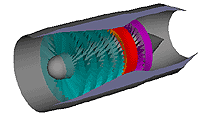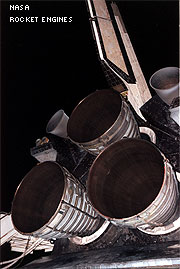Solar + Battery Car DIY STEM Kit
$11.99$5.95
 A jet engine works like this: It sucks in air from the front of the engine. This air is burned with the fuel within the engine. The resulting large mass of gas is ejected towards the rear at high velocity, which both propels the airplane forward, and gets more air sucked into the engine. In normal flight, the engines are used to propel the airplane _forward_. The actual 'uplift' is gained through the wings using the strong flow of the wind. (How actually the wings lift the airplane is a bit controversial, there is the 'Bernoulli' side, and the 'Newton' side... But that's another story.)
A jet engine works like this: It sucks in air from the front of the engine. This air is burned with the fuel within the engine. The resulting large mass of gas is ejected towards the rear at high velocity, which both propels the airplane forward, and gets more air sucked into the engine. In normal flight, the engines are used to propel the airplane _forward_. The actual 'uplift' is gained through the wings using the strong flow of the wind. (How actually the wings lift the airplane is a bit controversial, there is the 'Bernoulli' side, and the 'Newton' side... But that's another story.)
 Rockets can work anywhere, in vacuums, or in the atmosphere. A good example of this would be the space shuttle, which uses both of main types of rocket engines. The large nozzles you see at the bottom of the Shuttle itself and liquid-fueled rocket motors. They spray liquid hydrogen and liquid oxygen together, right at the bottom of the cone, which then burns as long as it continues to be fed fuel and oxygen. The rocket, however, doesn't use any air. It will work at any altitude, or in space. The problem is, though, that now, the craft must not only carry fuel... but it must carry oxygen as well. The huge brown tank on the belly of the Space Shuttle is the main fuel tank, holding both hydrogen and oxygen. To lift all that weight requires a LOT of energy, which requires more fuel, which requires more space, and weight; and at a certain point, using liquid-fueled rockets, you start to work against yourself. You can see how large the Saturn V rockets were compared to the Space Shuttle, and you can compare payloads. This is where the solid rocket boosters come in.
Rockets can work anywhere, in vacuums, or in the atmosphere. A good example of this would be the space shuttle, which uses both of main types of rocket engines. The large nozzles you see at the bottom of the Shuttle itself and liquid-fueled rocket motors. They spray liquid hydrogen and liquid oxygen together, right at the bottom of the cone, which then burns as long as it continues to be fed fuel and oxygen. The rocket, however, doesn't use any air. It will work at any altitude, or in space. The problem is, though, that now, the craft must not only carry fuel... but it must carry oxygen as well. The huge brown tank on the belly of the Space Shuttle is the main fuel tank, holding both hydrogen and oxygen. To lift all that weight requires a LOT of energy, which requires more fuel, which requires more space, and weight; and at a certain point, using liquid-fueled rockets, you start to work against yourself. You can see how large the Saturn V rockets were compared to the Space Shuttle, and you can compare payloads. This is where the solid rocket boosters come in.
 'You cannot hope to build a better world without improving the individuals. To that end each of us must work for his own improvement, and at the same time share a general responsibility for all humanity, our particular duty being to aid those to whom we think we can be most useful.'
'You cannot hope to build a better world without improving the individuals. To that end each of us must work for his own improvement, and at the same time share a general responsibility for all humanity, our particular duty being to aid those to whom we think we can be most useful.'